AGG 中文手册
1 渲染内存 Rendering Buffer
我们先从这里开始:在内存中开辟一块存储区,然后将它的内容以最简单的光栅格式写到文件中,也就
是 PPM(Portable Pixel Map)格式。虽然 Windows 对这种格式并没有原生的支持,但很多图像浏览器和
转换器都能使用这种格式,比如 IrfanView(www.irfanview.com)。所有 AGG 的控制台例子都使用了 P6
256 格式,也就是 RGB,每个字节代码一个颜色。现在假设我们将在下图所示的 RGB-buffer 内存区中工
作:
1.1 第一个简单例子
#include
#include
#include "agg_rendering_buffer.h"
enum
{
frame_width = 320,
frame_height = 200
};
// Writing the buffer to a .PPM file, assuming it has
// RGB-structure, one byte per color component
//--------------------------------------------------
bool write_ppm(const unsigned char* buf,
unsigned width,
unsigned height,
const char* file_name)
{
�
FILE* fd = fopen(file_name, "wb");
if(fd)
{
fprintf(fd, "P6 %d %d 255 ", width, height);
fwrite(buf, 1, width * height * 3, fd);
fclose(fd);
return true;
}
return false;
}
// Draw a black frame around the rendering buffer, assuming it has
// RGB-structure, one byte per color component
//--------------------------------------------------
void draw_black_frame(agg::rendering_buffer& rbuf)
{
unsigned i;
for(i = 0; i < rbuf.height(); ++i)
{
unsigned char* p = rbuf.row_ptr(i);
*p++ = 0; *p++ = 0; *p++ = 0;
p += (rbuf.width() - 2) * 3;
*p++ = 0; *p++ = 0; *p++ = 0;
}
memset(rbuf.row_ptr(0), 0, rbuf.width() * 3);
memset(rbuf.row_ptr(rbuf.height() - 1), 0, rbuf.width() * 3);
}
int main()
{
// In the first example we do the following:
//--------------------
// Allocate the buffer.
// Clear the buffer, for now "manually"
// Create the rendering buffer object
// Do something simple, draw a diagonal line
// Write the buffer to agg_test.ppm
// Free memory
unsigned char* buffer = new unsigned char[frame_width * frame_height * 3];
memset(buffer, 255, frame_width * frame_height * 3);
�
agg::rendering_buffer rbuf(buffer,
frame_width,
frame_height,
frame_width * 3);
unsigned i;
for(i = 0; i < rbuf.height()/2; ++i)
{
// Get the pointer to the beginning of the i-th row (Y-coordinate)
// and shift it to the i-th position, that is, X-coordinate.
//---------------
unsigned char* ptr = rbuf.row_ptr(i) + i * 3;
// PutPixel, very sophisticated, huh? :)
//-------------
*ptr++ = 127; // R
*ptr++ = 200; // G
*ptr++ = 98; // B
}
draw_black_frame(rbuf);
write_ppm(buffer, frame_width, frame_height, "agg_test.ppm");
delete [] buffer;
return 0;
}
在这个例子中,你甚至不需要链接任何的 AGG 的代码文件,你只需要在你的编译器命令行中设置好
AGG 的包含路径就行了。编译并运行它,你会看到现图所示的结果:
这个例子中几乎所有东西都“手工打制”的,使用的唯一一个现成的类是 rendering_buffer。这个类
本身并不知道关于内存中像素格式的任何信息,它只是保存了一个数组,数组中的元素分别指向每行(像
�
素的开头)。为申请和释放这块存储区是使用者的责任,你可以使用任何可行的方式来申请和释放内存,
比如使用系统提供的 API 函数,或是简单的用内存分配器(译注:应该是 new、delete、malloc、free 等),
甚至是直接使用一个静态数组。在上面这个例子中,因为每个像素要占用 3 个字节,所以我们申请了
width*height*3 字节的内存,在实际内存中是不存在“行”这种布局方式的,但这样做可以提高程序的性
能,而且有时候在使用 API 的时候需要。
1.2 Class rendering_buffer
包含文件: agg_rendering_buffer.h
rendering_buffer 这个类保存了指向每一行像素的指针,基本上这个类做的事就是这些了。看起来
好像不是什么了不起的事,不过我们还是继续分析下去。这个类的接口和功能都很简单,它只是模板类
row_ptr_cache 的一个 typedef 而已:
typedef row_ptr_cache rendering_buffer;
row_prt_cache 这个类的接口的功能如下:
template class row_ptr_cache
{
public:
row_ptr_cache();
row_ptr_cache(T* buf, unsigned width, unsigned height, int stride);
void attach(T* buf, unsigned width, unsigned height, int stride);
T* buf();
const T* buf() const;
unsigned width() const;
unsigned height() const;
int stride() const;
�
unsigned stride_abs() const;
T* row_ptr(int, int y, unsigned);
T* row_ptr(int y);
const T* row_ptr(int y) const;
row_data row (int y) const;
T const* const* rows() const;
template void copy_from(const RenBuf& src);
void clear(T value)
};
这个类的实现里没有使用断言或是验证的措施,所以,使用者有责任在用这个类对象时正确地将它初
始化到实际的内存块中,这可以在构造函数中完成,也可以使用 attach() 函数。它们的参数解释如下:
buf — 指向内存块的指针。
width — 以像素为单位表示的图像宽度。rendering buffer(渲染内存区)并不知道像
素格式和每个像素在内存中大小等信息。这个值会直接存储在 m_width 这个成员变量中,使用
width() 函数就可以获取它的值。
height — 以像素为单位表示的图像高度(同样也是行数)
stride — Stride(大步幅,-_-; 不知道怎么翻了„„),也就是用类型 T 来度量的一
行的长度。 rendering_buffer 是一个 typedef,也就是 row_prt_cache,所以这个值是
以字节数来算的。Stride 决定内存中每一行的实现长度。如果这个值是负的,那么 Y 轴的方向就
是反过来的。也就是说 Y 等 0 的点是是内在块的最后一行的。Y == height - 1 则是第一行。
stride 的绝对值也很重要,因为它让你可以方便地操作内存中的“行”(就像 windows 中的
BMP)。另外,这个参数允许使用者可以像操作整个内存区块一样,操作其中任意一个“矩形”内
存区。
attach()函数会改变缓冲区或是它的参数,它自己会为“行指针”数组重新分配内存,所以你可以在任何
时候调用它。当(且仅当)新的 height 值比之前使用过的最大的 height 值还要大时,它才会重新申请内
存。
构造的这个对象的开销仅仅是初始化它的成员变量(设置为 0),attach()的开销则是分配
sizeof(ptr)*height 个字节的内存,然后将这些指针指向对应的“行”。
�
最常使用的函数是 row_prt(y),这个函数只是简单地返回指向第 y 函数指针,这个指针指向的位置已
经考虑到了 Y 轴的方向了。
注意:
渲染内存区(rendering buffer)并不管任何裁减或是边界检查的事,这是更高层的类的责任。
buf(), width(), height(), stride(), stride_abs() 这些函数的意义显而易见,就不解释了。
copy_from()函数会将其它内存的内容拷贝至“本”内存中。这个函数是安全的,如果(两者的)width
和 height 值不相同,那它会尽可能拷贝大一些的区域。一般来讲都用于拷贝相同大小区域。
1.3 Two Modifications of the Example
首先,在创建 rendering buffer 的对象时将 stride 取负值:
agg::rendering_buffer rbuf(buffer,
frame_width,
frame_height,
-frame_width * 3);
那么结果将变成这样:
然后,我们试下将 rendering buffer 附着(attach)到被分配的内存区的某部分。这个修改会使得
rendering buffer 两次附着在同一块内存区上,第一次是整个被分配的内存区域,第二次是其中的一部
分:
�
int main()
{
unsigned char* buffer = new unsigned char[frame_width * frame_height * 3];
memset(buffer, 255, frame_width * frame_height * 3);
agg::rendering_buffer rbuf(buffer,
frame_width,
frame_height,
frame_width * 3);
// Draw the outer black frame
//------------------------
draw_black_frame(rbuf);
// Attach to the part of the buffer,
// with 20 pixel margins at each side.
rbuf.attach(buffer +
frame_width * 3 * 20 + // initial Y-offset
3 * 20, // initial X-offset
frame_width - 40,
frame_height - 40,
frame_width * 3 // Note that the stride
// remains the same
);
�
// Draw a diagonal line
//------------------------
unsigned i;
for(i = 0; i < rbuf.height()/2; ++i)
{
// Get the pointer to the beginning of the i-th row (Y-coordinate)
// and shift it to the i-th position, that is, X-coordinate.
//---------------
unsigned char* ptr = rbuf.row_ptr(i) + i * 3;
// PutPixel, very sophisticated, huh? :)
//-------------
*ptr++ = 127; // R
*ptr++ = 200; // G
*ptr++ = 98; // B
}
// Draw the inner black frame
//------------------------
draw_black_frame(rbuf);
// Write to a file
//------------------------
write_ppm(buffer, frame_width, frame_height, "agg_test.ppm");
delete [] buffer;
�
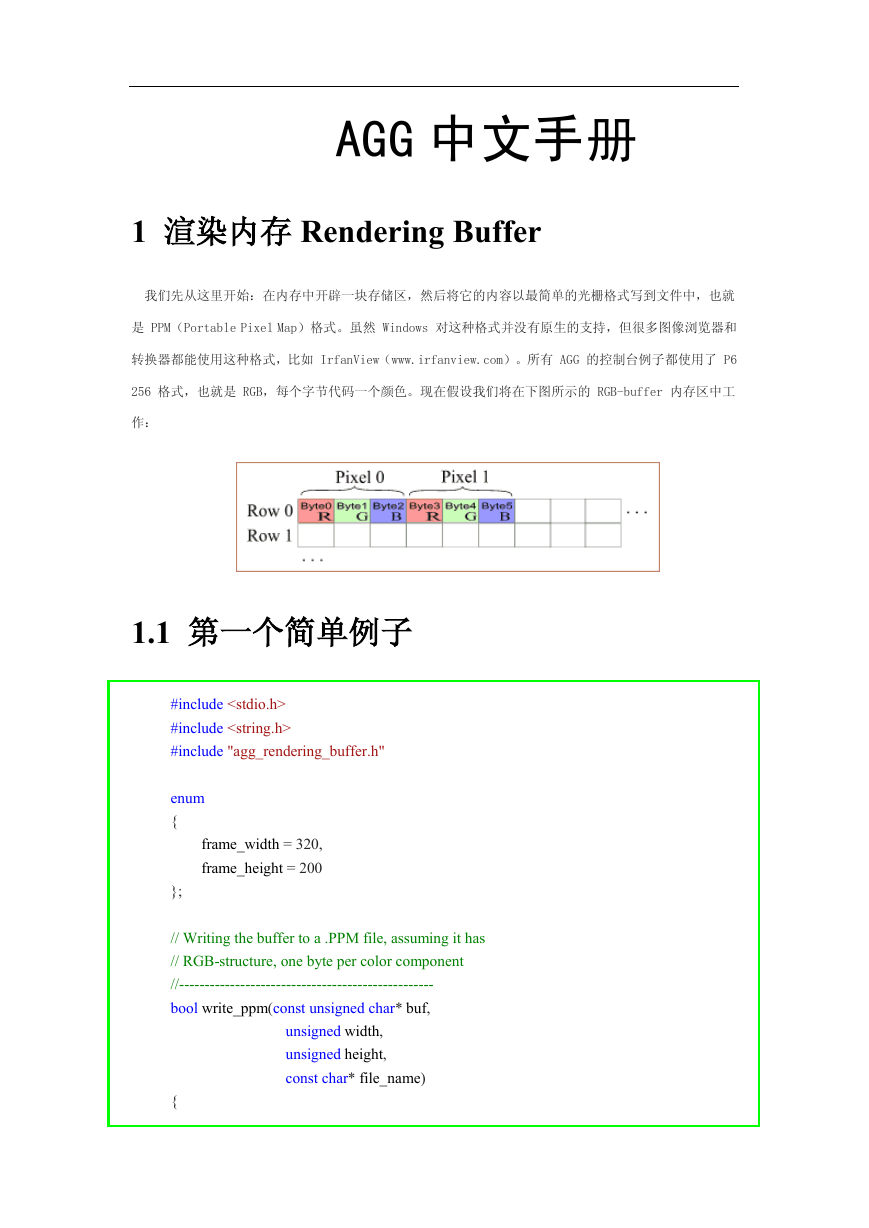
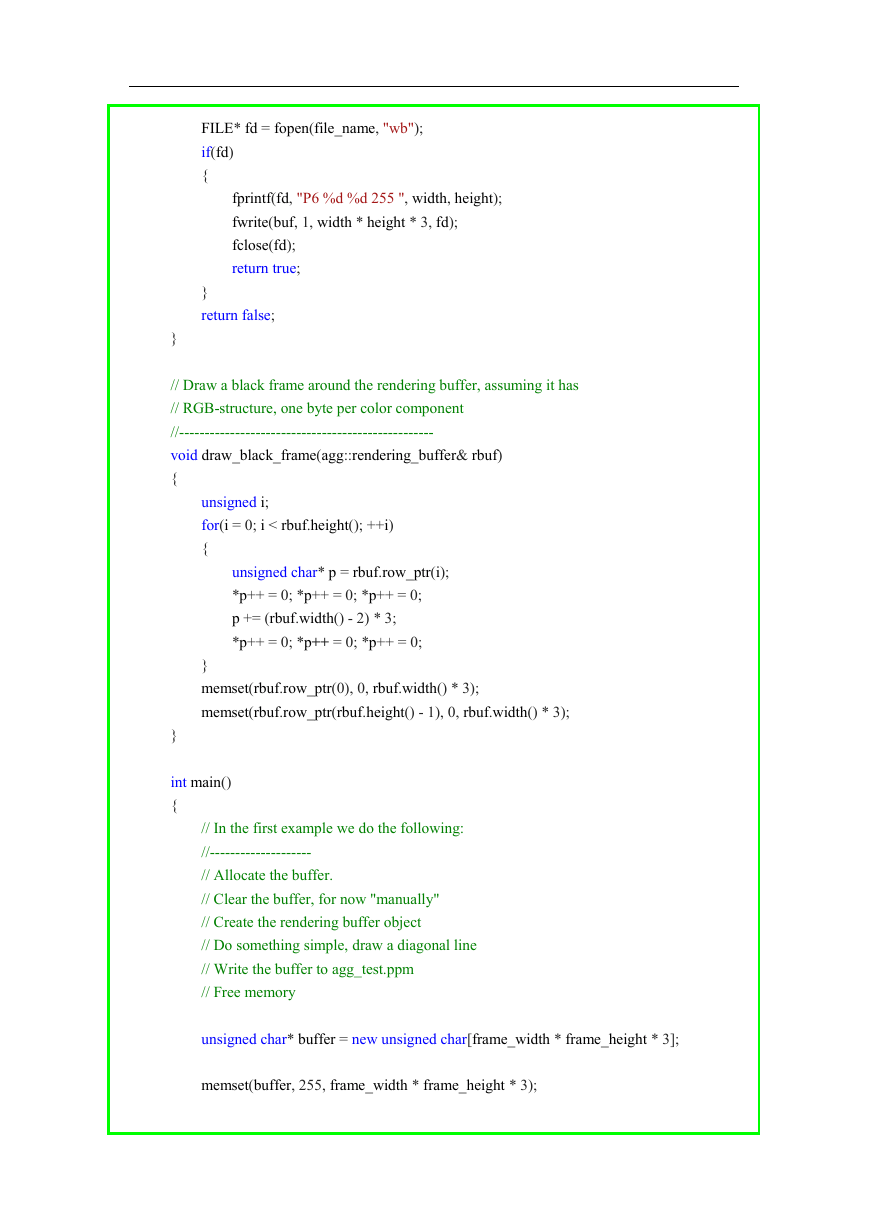
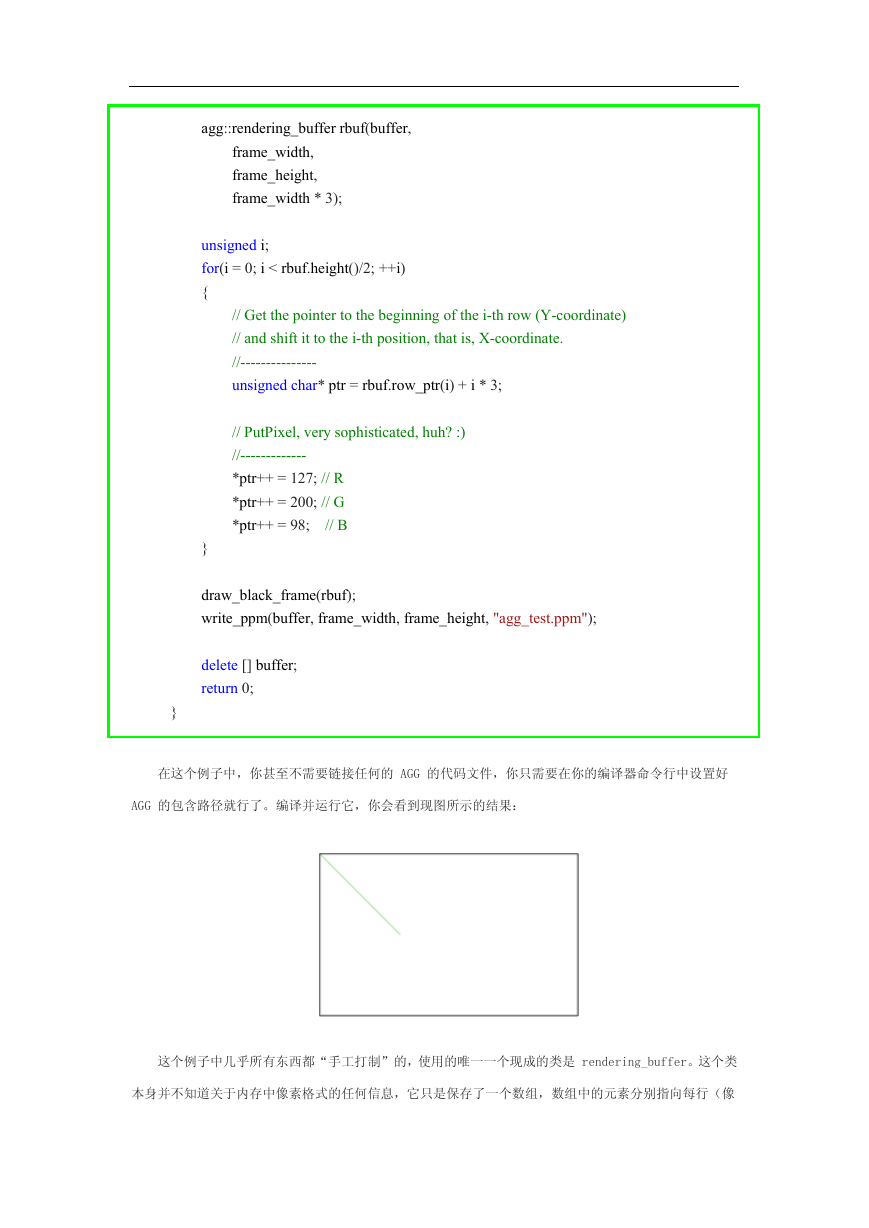
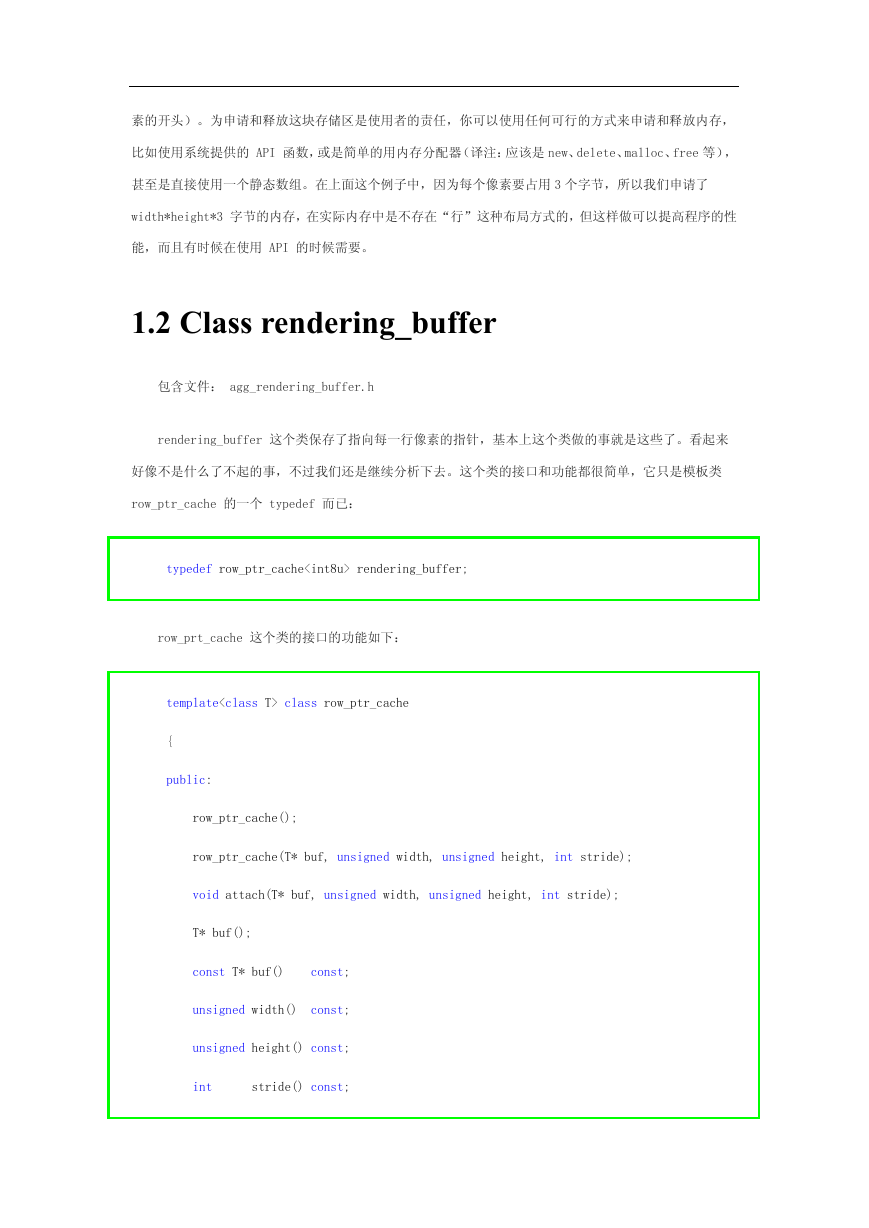
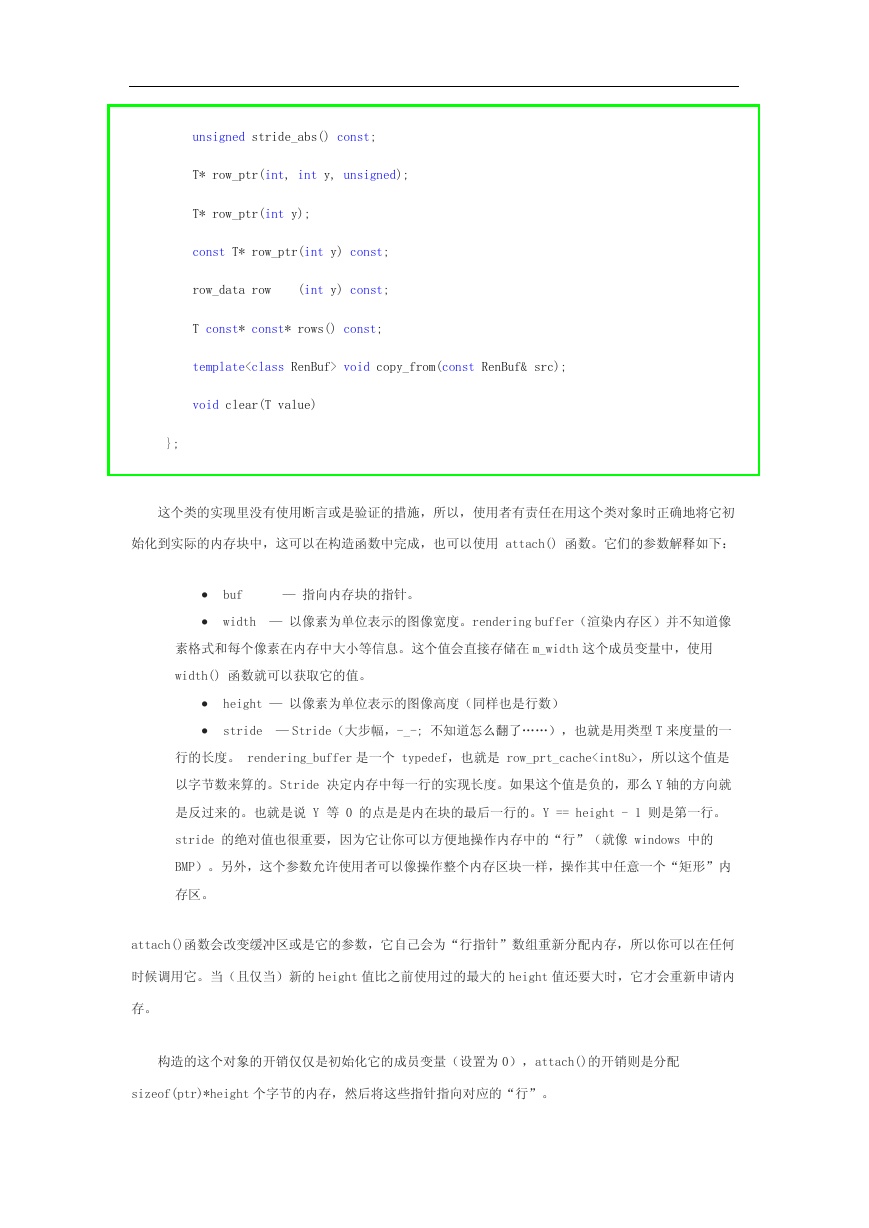
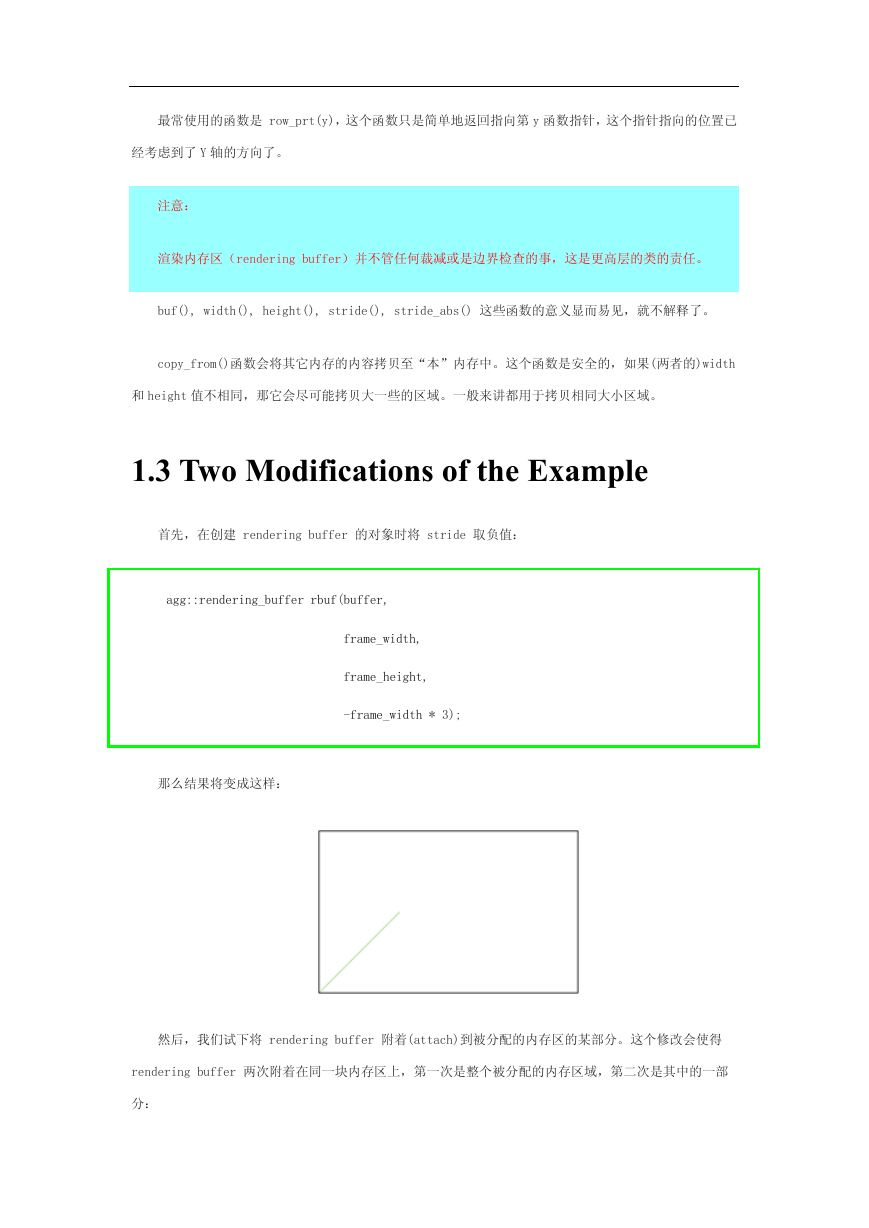
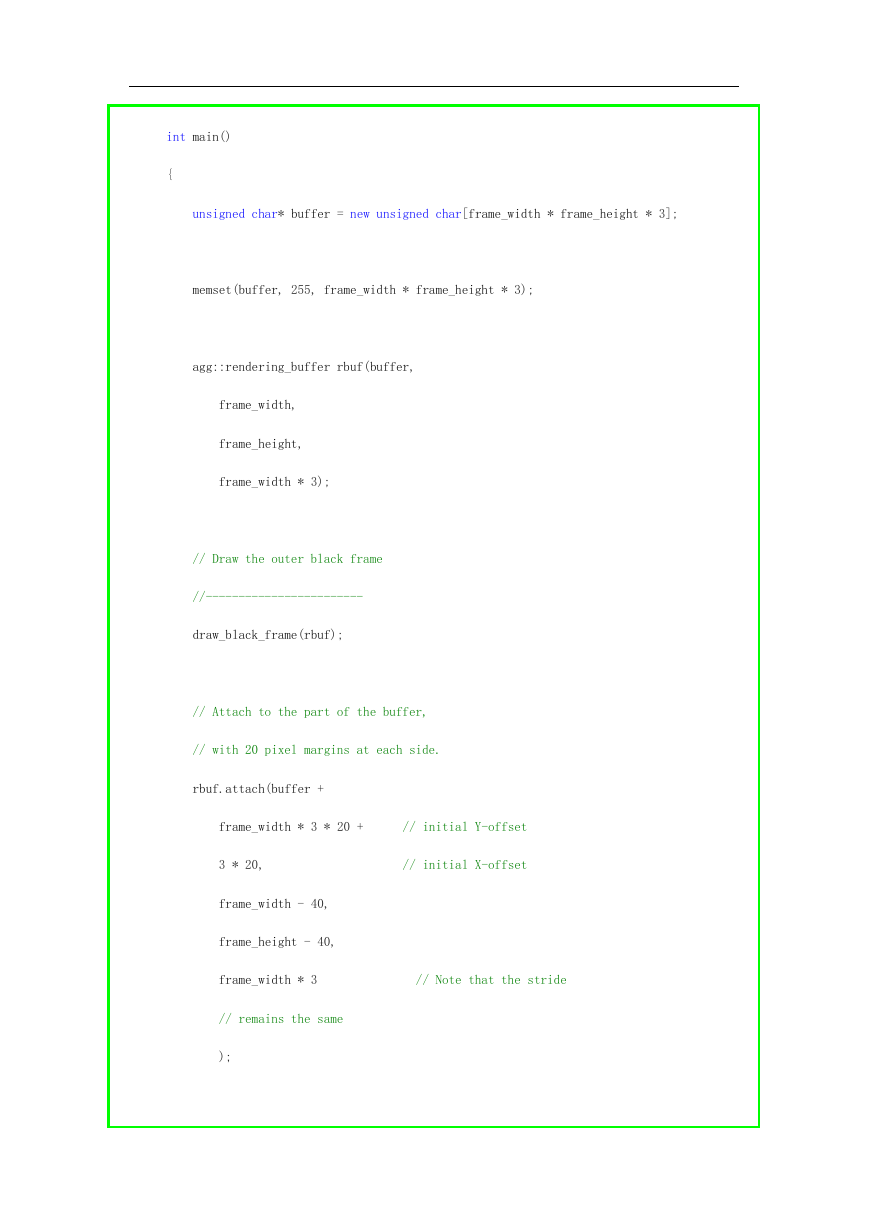
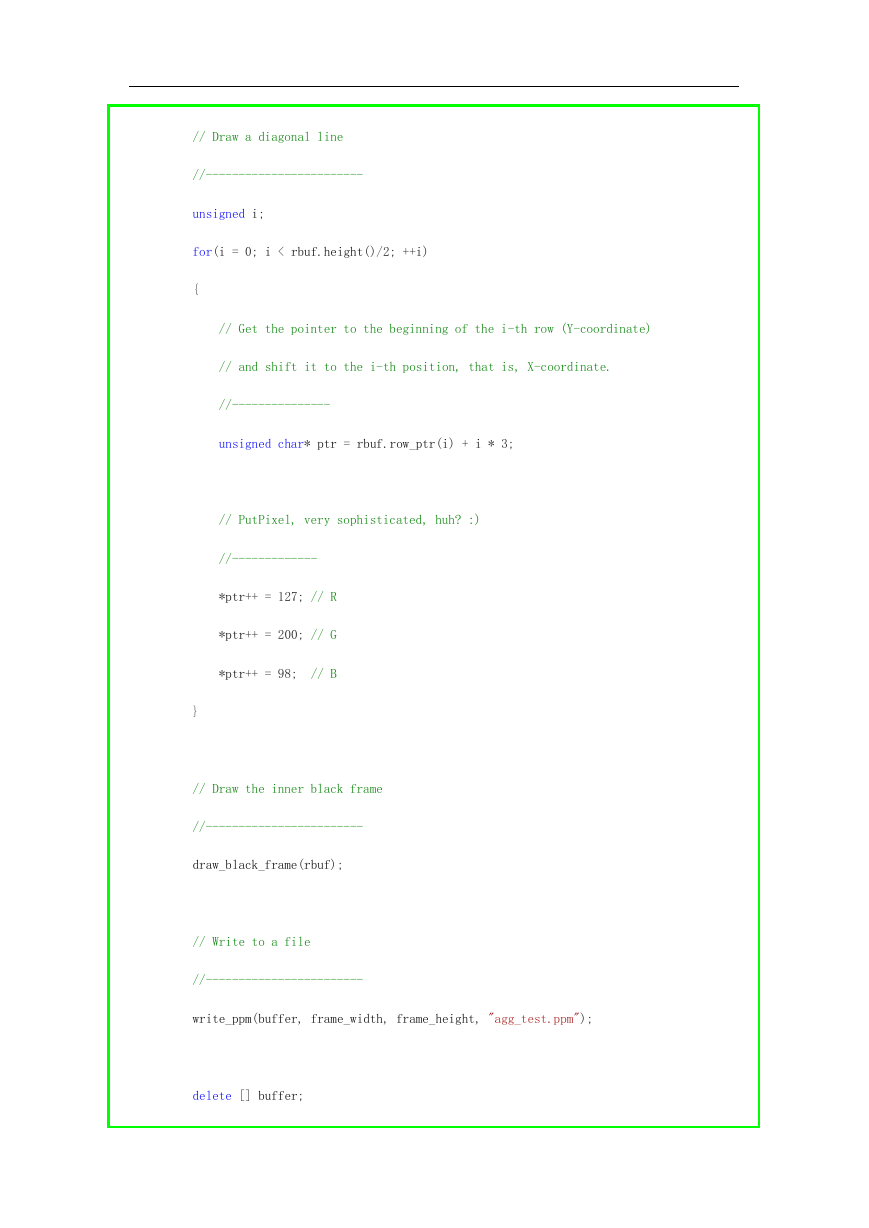








 2023年江西萍乡中考道德与法治真题及答案.doc
2023年江西萍乡中考道德与法治真题及答案.doc 2012年重庆南川中考生物真题及答案.doc
2012年重庆南川中考生物真题及答案.doc 2013年江西师范大学地理学综合及文艺理论基础考研真题.doc
2013年江西师范大学地理学综合及文艺理论基础考研真题.doc 2020年四川甘孜小升初语文真题及答案I卷.doc
2020年四川甘孜小升初语文真题及答案I卷.doc 2020年注册岩土工程师专业基础考试真题及答案.doc
2020年注册岩土工程师专业基础考试真题及答案.doc 2023-2024学年福建省厦门市九年级上学期数学月考试题及答案.doc
2023-2024学年福建省厦门市九年级上学期数学月考试题及答案.doc 2021-2022学年辽宁省沈阳市大东区九年级上学期语文期末试题及答案.doc
2021-2022学年辽宁省沈阳市大东区九年级上学期语文期末试题及答案.doc 2022-2023学年北京东城区初三第一学期物理期末试卷及答案.doc
2022-2023学年北京东城区初三第一学期物理期末试卷及答案.doc 2018上半年江西教师资格初中地理学科知识与教学能力真题及答案.doc
2018上半年江西教师资格初中地理学科知识与教学能力真题及答案.doc 2012年河北国家公务员申论考试真题及答案-省级.doc
2012年河北国家公务员申论考试真题及答案-省级.doc 2020-2021学年江苏省扬州市江都区邵樊片九年级上学期数学第一次质量检测试题及答案.doc
2020-2021学年江苏省扬州市江都区邵樊片九年级上学期数学第一次质量检测试题及答案.doc 2022下半年黑龙江教师资格证中学综合素质真题及答案.doc
2022下半年黑龙江教师资格证中学综合素质真题及答案.doc